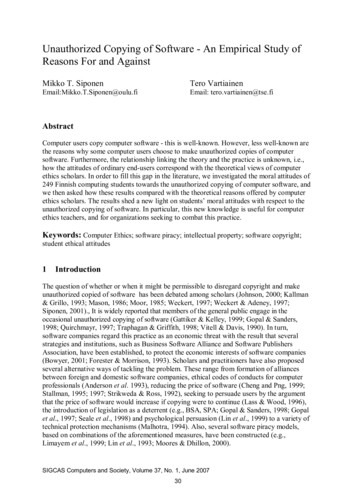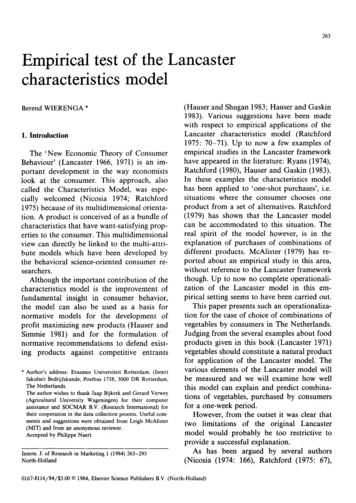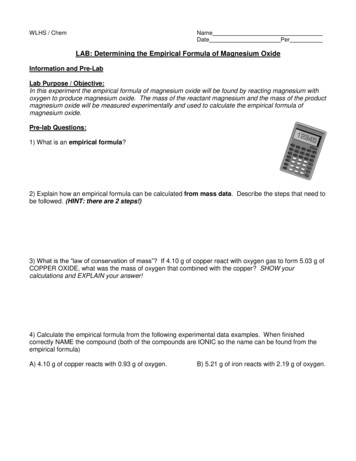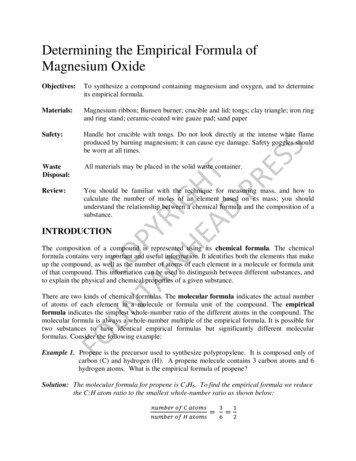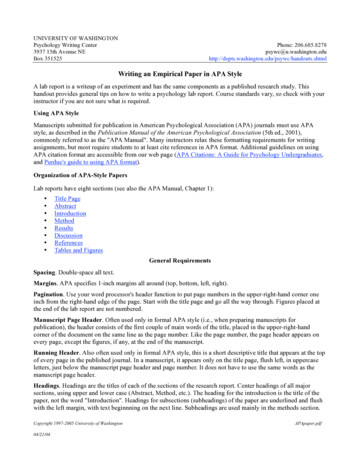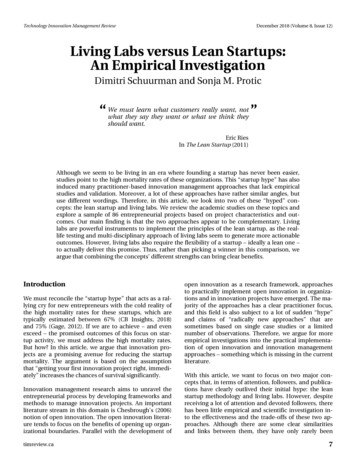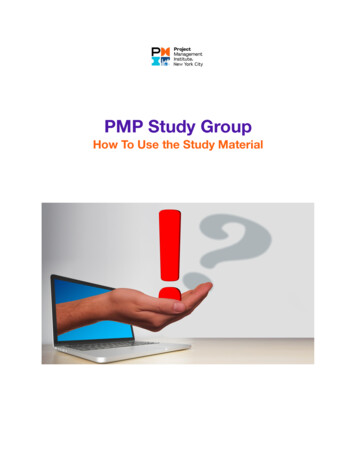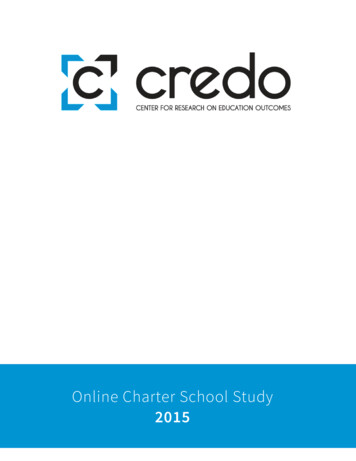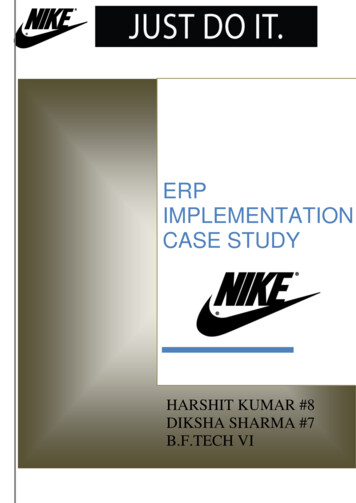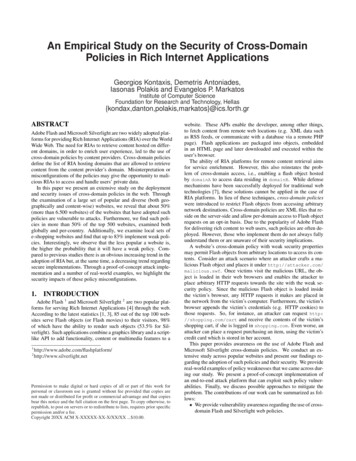
Transcription
An Empirical Study on the Security of Cross-DomainPolicies in Rich Internet ApplicationsGeorgios Kontaxis, Demetris Antoniades,Iasonas Polakis and Evangelos P. MarkatosInstitute of Computer ScienceFoundation for Research and Technology, rABSTRACTAdobe Flash and Microsoft Silverlight are two widely adopted platforms for providing Rich Internet Applications (RIA) over the WorldWide Web. The need for RIAs to retrieve content hosted on different domains, in order to enrich user experience, led to the use ofcross-domain policies by content providers. Cross-domain policiesdefine the list of RIA hosting domains that are allowed to retrievecontent from the content provider’s domain. Misinterpretation ormisconfigurations of the policies may give the opportunity to malicious RIAs to access and handle users’ private data.In this paper we present an extensive study on the deploymentand security issues of cross-domain policies in the web. Throughthe examination of a large set of popular and diverse (both geographically and content-wise) websites, we reveal that about 50%(more than 6.500 websites) of the websites that have adopted suchpolicies are vulnerable to attacks. Furthermore, we find such policies in more than 50% of the top 500 websites, examined bothglobally and per-country. Additionally, we examine local sets ofe-shopping websites and find that up to 83% implement weak policies. Interestingly, we observe that the less popular a website is,the higher the probability that it will have a weak policy. Compared to previous studies there is an obvious increasing trend in theadoption of RIA but, at the same time, a decreasing trend regardingsecure implementations. Through a proof-of-concept attack implementation and a number of real-world examples, we highlight thesecurity impacts of these policy misconfigurations.1.INTRODUCTIONAdobe Flash 1 and Microsoft Silverlight 2 are two popular platforms for serving Rich Internet Applications [4] through the web.According to the latest statistics [1, 3], 85 out of the top 100 websites serve Flash objects (or Flash movies) to their visitors, 98%of which have the ability to render such objects (53.5% for Silverlight). Such applications combine a graphics library and a scriptlike API to add functionality, content or multimedia features to ilverlight.netPermission to make digital or hard copies of all or part of this work forpersonal or classroom use is granted without fee provided that copies arenot made or distributed for profit or commercial advantage and that copiesbear this notice and the full citation on the first page. To copy otherwise, torepublish, to post on servers or to redistribute to lists, requires prior specificpermission and/or a fee.Copyright 20XX ACM X-XXXXX-XX-X/XX/XX . 10.00.website. These APIs enable the developer, among other things,to fetch content from remote web locations (e.g. XML data suchas RSS feeds, or communicate with a database via a remote PHPpage). Flash applications are packaged into objects, embeddedin an HTML page and later downloaded and executed within theuser’s browser.The ability of RIA platforms for remote content retrieval aimsfor service enrichment. However, this also reinstates the problem of cross-domain access, i.e., enabling a flash object hostedby domainA to access data residing in domainB. While defensemechanisms have been successfully deployed for traditional webtechnologies [7], these solutions cannot be applied in the case ofRIA platforms. In lieu of these techniques, cross-domain policieswere introduced to restrict Flash objects from accessing arbitrarynetwork destinations. Cross-domain policies are XML files that reside on the server-side and allow per-domain access to Flash objectrequests on an opt-in basis. Due to the popularity of Adobe Flashfor delivering rich content to web users, such policies are often deployed. However, those who implement them do not always fullyunderstand them or are unaware of their security implications.A website’s cross-domain policy with weak security propertiesmay permit Flash objects from arbitrary locations to access its contents. Consider an attack scenario where an attacker crafts a malicious Flash object and places it under http://attacker.com/malicious.swf. Once victims visit the malicious URL, the object is loaded in their web browsers and enables the attacker toplace arbitrary HTTP requests towards the site with the weak security policy. Since the malicious Flash object is loaded insidethe victim’s browser, any HTTP requests it makes are placed inthe network from the victim’s computer. Furthermore, the victim’sbrowser appends the victim’s credentials (e.g. HTTP cookies) tothose requests. So, for instance, an attacker can request http://shopping.com/cart and receive the contents of the victim’sshopping cart, if she is logged in shopping.com. Even worse, anattacker can place a request purchasing an item, using the victim’scredit card which is stored in her account.This paper provides awareness on the use of Adobe Flash andMicrosoft Silverlight cross-domain policies. We conduct an extensive study across popular websites and present our findings regarding the adoption of such policies and their security. We providereal-world examples of policy weaknesses that we came across during our study. We present a proof-of-concept implementation ofan end-to-end attack platform that can exploit such policy vulnerabilities. Finally, we discuss possible approaches to mitigate theproblem. The contributions of our work can be summarized as follows: We provide vulnerability awareness regarding the use of crossdomain Flash and Silverlight web policies.
1234567 ?xml version "1.0"? !DOCTYPE cross-domain-policy SYSTEM olicy.dtd" cross-domain-policy allow-access-from domain "sub1.domainA.com"/ allow-access-from domain "domainC.com"/ /cross-domain-policy Listing 1: A valid cross-domain policy123 allow-access-from domain "*.sub1.domainA.com"/ allow-access-from domain "*.domainC.com"/ allow-access-from domain "*"/ Listing 2: Weak directives in a cross-domain policy We present an extensive study on the deployment and securityof Flash and Silverlight cross-domain policy files. Our resultsreveal more than 6.500 websites with weak policies and, thus,vulnerable to attacks. We present proof-of-concept implementations of attack scenarios that target weak cross-domain policies for Flash andSilverlight enabled websites.2.BACKGROUNDThis section provides background information on the internals ofthe Adobe Flash cross-domain policy and describes in detail severaltypes of weak implementations. Microsoft Silverlight employs analmost identical policy system.2.1Adobe Flash cross-domain policyFor security reasons, an Adobe Flash object rendered in a webbrowser, via the Adobe Flash Player plugin, is not allowed to access data that resides outside the web domain on which the objectis hosted. The basis of domain comparison is the domain name,not an IP address. The two domains must be an exact match,so a comparison of http://www.domainA.com with http://images.domainA.com, or https://www.domainA.com will fail.The Flash player is responsible for enforcing this security measure.However, there are cases where access to data in a different domain is required. For that matter, the Flash player is able to processa white-list-oriented XML policy file, named crossdomain.xml,hosted on the remote domain from which data is requested.In detail, once a Flash object, located at domainA, attempts toaccess remote domainB, the Flash player, which is responsible forrendering the object, contacts the host computer of domainB andrequests the policy file. If the file is unavailable, the Flash playerterminates the network access attempt. If a policy has been definedby the administrator of domainB, then the Flash player determineswhether it explicitly allows access from the Flash object’s own domain. If access has been authorized, the player places the networkrequest in question, and returns the response to the calling FlashObject, running inside the user’s web browser. Otherwise the network access attempt is terminated and data requests are never issued. Listing 1 shows an example of a well-defined cross-domainpolicy file from domainA. Only requests from sub1.domainA.com(line 4) and domainC.com (line 5) are allowed.To extend the previous scenario, one can consider the case wheredomainA has several subdomains that host Flash objects requiringaccess to content hosted on domainB. To enable such access, thepolicy file under domainB must contain multiple “allow-accessfrom” directives, one for each subdomain. However, it is also pos-sible to use the wildcard character to match, and therefore include,any subdomain of domainA or simply any domain. The latter practice may seem more convenient and with the least administrativeoverhead in terms of maintaining the list of cooperating domains.However, problems arise when a policy is not tailored to a specificdomain’s design and structure, allowing an adversary to take advantage of it.2.2Weak Policy ImplementationsIn this section we present the weak policy implementations andexplain the potential attacks they can lead to.Any sub-domain weakness. The use of a wildcard to match anysubdomain might create a potential security weakness. If users areable to upload content to a specific subdomain, an attacker couldupload a Flash object of his own and, by running arbitrary code,be able to place requests towards the target subdomain and receivethe responses. Assuming the target subdomain requires some formof authentication in order to accept requests and not all users havesuch, a malicious user could lure an authenticated user (victim) tovisit his malicious Flash object. Once the malicious Flash object isloaded in the victim’s browser, any requests towards the target subdomain will carry the victim’s credentials, contained in an HTTPcookie or a session variable, and will originate from the victim’s IPaddress. Thus, the adversary is able to launch a Cross-Site RequestForgery (CSRF) attack as CSRF defense mechanisms [7] are rendered ineffective. Lines 1 and 2 from Listing 2 are examples of thesub-domain weakness.Any domain weakness. In the case where multiple different domains require access to data on domainA, a policy will have to bedefined with multiple “allow-access-from” directives, one for eachdistinct domain. However, a single directive can be defined, using the wildcard to match against domains. This means that notonly the previous set of domains will gain access, but any domain,e.g. http://attacker.com. This is the most dangerous type ofweakness because it allows the malicious Flash object to be hostedanywhere, from the attacker’s home computer to an arbitrary freehosting service on the web. While in the previous situation theattacker must be able to upload something to a white-listed subdomain of domainA, which may not always be possible, in this caseshe is not restricted in any way. Flickr, a major image and videohosting website, had such a weak policy implementation 3 . Line 3from Listing 2 is an example of the any-domain weakness.Throughout this paper, unless otherwise specified, we use theterm “weak” to describe only policies with any-domain, unrestrictedaccess directives, as they are the most dangerous and always exploitable. This places a lower limit to the count of vulnerable sitesas it does not include the exploitable any-subdomain policies, theexact number of which is unknown due to their case-specific nature.3.DATA COLLECTIONTo examine both the policy usage and security issues of crossdomain policies we created a number of diverse (both geographically and content-wise) lists of websites. Our first and larger listincludes the 100K most popular websites, according to Alexa 4 . Webelieve this to represent a complete list of both popular and not sopopular websites. Furthermore, we compiled a list with the websites of the Fortune 500 companies to fill our global view set. Forour geographically diverse set, formed by popular sites in a morelocal scale, we used lists with the 500 most popular websites, againaccording to Alexa, in the U.S.A, Great Britain, Germany, tmlhttp://www.alexa.com/
Top100 AdoptionTop100K AdoptionTop100 SecurityTop100K Security75%25%14%2006 Adoption2011 Adoption86%36%Figure 1: Global Alexa Top100, Top100K84%52%64%62%16%2006 Security48%83%2011 Security0%100Some Policy25%No Policy8050%75%38%Figure 3: Alexa Top100 US17%79%21%100%0%Domain RestrictedAny Domain% of sites having policies up to rank i% of weak policies up to rank iSome Policy25%No Policy50%75%Domain Restricted100%Any Domain6040200010100Rank1K10K100K2006 Adoption 8%16%2011 Adoption92%84%Figure 2: Correlation of policy adoption and security with sitepopularity rank.Figure 4: Fortune5002006 Security2011 Securityand Greece. Additionally, we have used a list with 500 of the mostpopular Greek e-shopping websites to form a set of content-specificsites in our country.For each domain name in those lists we placed the following requests: http[s]://domain/crossdomain.xml and http[s]://www.domain/crossdomain.xml to download the policy filefor Adobe Flash if one existed. A respective batch of requestswas also sent to retrieve the policy file for Microsoft Silverlight.We subsequently examined those XML files and identified the domains that did return a valid policy. Furthermore, we evaluated thevalid policies to automatically identify both types of weak implementations described in section 2.2. Our findings are presented inthe following section. We focus on the findings from the http://www.domain requests as they represent the most common caseand their differences with the results of the other requests are minor.4.4.1POLICY ADOPTION AND SECURITYGlobal PenetrationWe first examine the cross domain policy adoption at a globalscale. Recall that the existence of a crossdomain policy file does notstate whether a website supports RIA plugins or not, but whethera website allows RIA plugins to request and receive data from it.Figure 1 (top) presents our findings for the Top 100 and Top 100Kwebsites, while Table 1 summarizes our findings for all sub-classesexamined. We can see that the penetration ratio of domain policies diminishes as the total number of examined sites grows. Forexample, 75 out of the Top 100 sites serve a policy file, while thispercentage drops to only 14% for the Top 100K sites. Furthermore,as we see in the bottom bars of Figure 1, security awareness alsodiminishes. That is, top popular sites seem to restrict their policiesmore carefully than not so popular sites – only 16% are weak casesfor the Top 100 vs. almost 50% for the Top 100K sites.To further understand the evolution of weak implementations asthe site’s rank moves away from the top, Figure 2 plots the cumulative percentage of weak policies in relation to the site’s rank. Wecan observe a clear trend here; the less popular the site is, the higherthe probability the website will have implemented a weak policy.4.20%75%25%75%25%Country Penetration25%50%75%100%We continueour examinationby lookingat the cross-domainNo PolicyDomain RestrictedAny Domainpolicy adoption at a more local scale. To do so, we study thepolicy penetration for the U.S.A. and a number of major European countries. Table 2 summarizes our results. Countries like theU.S.A. with a high adoption rate (57%) of cross-domain policieshave fewer weak policies (28% of deployed policies) than countrieslike Greece where the adoption rate is much lower (36%) but thereare more weak policies (39%).This indicates that countries wheresuch policies are more widely used are also more security-aware.In a similar study, in 2006, Grossman [2] examined the crossdomain policy files for the top 100 sites in the U.S.A., accordingto Alexa, and the websites of the Fortune 500 list of companies.With a penetration of 36% and 8% respectively, Grossman found6% and 2% to be wildcarded for any-domain. In January 2011, were-examined the two lists. Figure 3 presents our findings along withthe findings of the Grossman study. We see an increase in the penetration of cross-domain policies in 2011. More than 60% of thesites implement a cross-domain policy in the Alexa U.S.A top 100,an increase of almost 173% since 2006. Alarmingly, the number ofweak policy deployments has also increased to 21%, exhibiting agrowth of 124% since 2006. This indicates that, since 2006, moresites have adopted cross-domain policies, which is not surprisingconsidering the capabilities of Flash technology. What is surprisingthough, is that the percentage of sites implementing weak policieshas also increased and its increase is almost 70% of the growth rateof Flash technology adoption. In the case of the Fortune 500 sites,the penetration of such policies has doubled while the ratio of weakimplementations has remained the same. The two groups of siteshave a dice coefficient of 0.14, indicating two very different sets;the first one is more dynamic in terms of Flash technology adoption than the latter and appears to have more secure policies. Atthe same time, however, it also exhibits an increasing trend towardsweak implementations.Some Policy4.3Category PenetrationBesides examining local sites in each country, we examine specific site categories as provided by Alexa. In detail, we inspectthe 500 most popular sites in a series of categories. Table 3 sum-
NoneTierAlexa Top 100Alexa Top 1KAlexa Top 10KAlexa Top 100KFortune 50025%48%71%86%84%Adobe FlashSome 8%75%25%None97%98%99%99%-Microsoft SilverlightSome 8%-Table 1: Adobe Flash Cross-domain Policy and Microsoft Silverlight Client-access Policy adoption and security evaluation for the100K most popular sites according to Alexa.NoneCountryU.S.A.GermanyGreat BritainFranceGreece43%55%58%63%64%Adobe FlashSome 8%61%39%None97%99%98%99%99%Microsoft SilverlightSome 5%50%50%Table 2: Adobe Flash Cross-domain Policy and Microsoft Silverlight Client-access Policy adoption and security evaluation for the500 most popular sites in the U.S.A. and major European 52%62%83%67%82%68%68%Adobe FlashSome PolicyRestricted %34%68%32%69%31%72%28%83%17%Table 3: Policy adoption and security evaluation for the top-500sites in a series of content categories.marizes our results. Cross-domain policies are adopted in 16% to46% of the sites, depending on category. We can see that shoppingsites are more aware of the security implications, with only 17%having unrestricted policies. All other categories have unrestrictedpolicies in a larger percentage, ranging from 28% and up to 51%.We also examined the sites for Microsoft Silverlight, but omit theresults due to the small adoption rate (less than 2% in all cases) andthe lack of space.Greek E-Shopping Sites: To examine both local and categoryspecific websites we assembled a set with 500 popular Greek eshopping sites by crawling the catalog of Skroutz 5 , a popular Greeke-shopping search engine. Although, the adoption of cross-domainpolicy files is rather low (2.5%), the percentage of any-domain,unrestricted-access policies reaches an impressive 83.3%. Considering the nature of these sites (i.e., online shopping involving useraccounts, personal and financial details), one can imagine the impact of an attack against their users.4.4Administrative OverheadIn the previous sections we have seen that an important numberof cross-domain policies are vulnerable to attacks. In t
Policies in Rich Internet Applications Georgios Kontaxis, Demetris Antoniades, . The ability of RIA platforms for remote content retrieval aims for service enrichment. However, this also reinstates the prob- . The basis of domain comparison is the domain name, n

